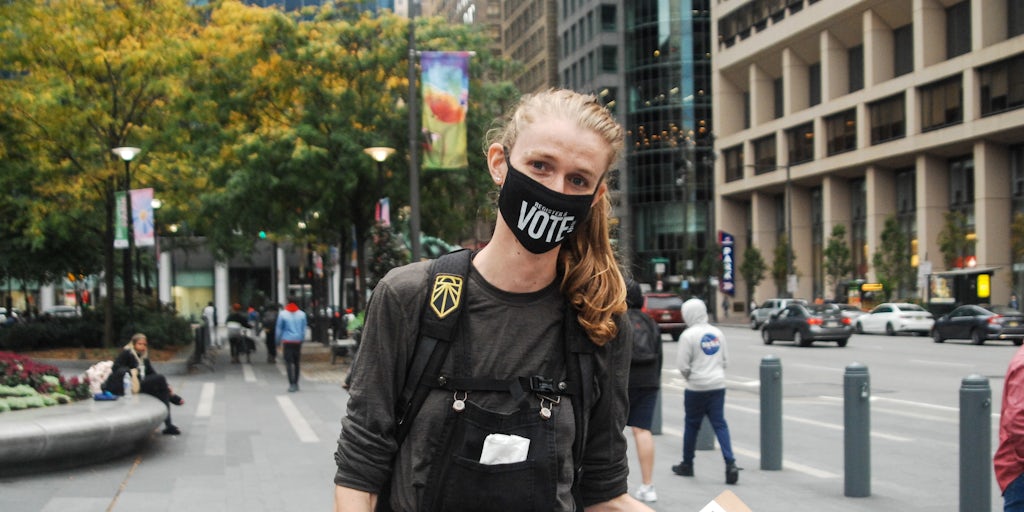How Is Fashion Voting in the US Election? | BoF Professional, The Week Ahead
THE CHEAT SHEET
A Consequential Election

Fashion labels ranging from Pyer Moss to Studio 189 have released products on the theme of voting. | Source: Courtesy
- Polling averages show former Vice President Joe Biden leading President Donald Trump heading into the Nov. 3 election
- Economic stimulus, the pandemic response, climate policy, corporate taxes and other issues hang in the balance
- Brands are boarding up stores and taking out insurance in case the outcome sparks civil unrest
If it were up to the people who work in fashion, Joe Biden would win in a landslide. Less clear is what the industry’s leaders want. If a Biden administration quickly passes an economic stimulus package, brings the pandemic under control and supports an orderly distribution of a vaccine, it will boost the industry’s fortunes across the board. Executives are probably less enamoured with Biden’s proposal to raise the corporate tax rate, and some brands and manufacturers may be dreading new labour and environmental regulations.
We still have to get through election night itself, of course. A close election could mean weeks of vote counting and legal wrangling before a winner is determined (and some fear Trump may dispute the results if he doesn’t like the outcome). Retailers are preparing for the worst, with some boarding up stores in major cities and taking out insurance in case stores are damaged during civil unrest.
The Bottom Line: The election will almost certainly be a referendum on which candidate is better equipped to tackle the pandemic, and that’s how fashion is likely to view it too. Until Covid-19 is brought under control, fashion cannot thrive.
Richemont Tries to Shake the Hard Luxury Blues

Cartier and other Richemont brands will face tougher competition from an LVMH-owned Tiffany | Source: Getty Images
- Richemont reports results for the six months ending Sept. 30 on Nov. 6
- LVMH and Tiffany agreed last week to complete a deal that would see the American jewellery brand sold for $15.8 billion
- LVMH, Kering and other large luxury fashion companies have reported surprisingly strong quarterly sales
Richemont appeared to have dodged a bullet for a moment there, when LVMH appeared ready to walk away from its acquisition of Tiffany. That deal is back on, and once completed will give the Swiss firm a true global rival in the jewellery market for the first time. Richemont has plenty of other challenges: its shares are down nearly 25 percent this year, compared with a 3 percent dip for LVMH, reflecting expectations watches and jewellery will take longer to recover from the pandemic than fashion and leather goods. The company’s problems – including the rise of smartwatches and its troubled fashion and YNAP units – predate the pandemic, however.
Industry figures show strong demand for watches in China, but dismal sales virtually everywhere else. Richemont clearly sees its future in Asia; it’s no coincidence that Watches & Wonders, where the company’s brands show off their newest creations, was moved to Shanghai this year.
The Bottom Line: Richemont’s approach to e-commerce is another element to watch this week. Though the company owns Net-a-Porter and Watchfinder, a resale platform, many of its brands are loathe to sell five- and six-figure watches and jewellery online. The pandemic has forced luxury brands of all types to rethink their approach, and competition from an LVMH-backed Tiffany is sure to spur innovation as well.
Black Friday Is Already Here

The days when shoppers packed stores on Black Friday are long gone | Source: Reuters
- Many retailers started promoting holiday sales in late October, and the shopping season is likely to be in full swing by the end of this week
- Holiday spending was already moving online pre-pandemic; this year, expect far more sales to take place digitally
- US consumer confidence is falling, and analysts warn economic conditions may deteriorate further if more lockdowns are necessary
The first “Black Friday” sales started appearing in consumers’ inboxes in mid-October, more than a month before the all-important retail holiday. But it’s in early November when the promotions start to kick into high gear. Retailers have their work cut out for them to salvage the all-important holiday season. A National Retail Federation survey found consumers plan to spend about 8 percent less on gifts in the weeks leading into the holidays — but 28 percent less on themselves.
That only partially explains the particularly early and aggressive promotions this year. Retailers are also gaming out ways to spread orders over a longer period to avoid holiday shipping delays. They will try anything that shifts orders away from the busiest shipping periods, when they’ll have to pay as much as $2 more per package.
The Bottom Line: The rapidly worsening pandemic at least gives retailers some clarity about how the rest of the holiday shopping season is likely to play out. With cases spiking and lockdowns looming, they can bank on a hefty portion of spending taking place online rather than in stores.
SUNDAY READING
Professional Exclusives You May Have Missed:
The Week Ahead wants to hear from you! Send tips, suggestions, complaints and compliments to [email protected].
Was this BoF Professional email forwarded to you? Join BoF Professional to get access to the exclusive insight and analysis that keeps you ahead of the competition. Subscribe to BoF Professional here.

